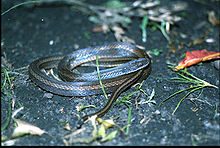- Coniophanes
-
Coniophanes 
Coniophanes fissidens Scientific classification Kingdom: Animalia Phylum: Chordata Subphylum: Vertebrata Class: Reptilia Order: Squamata Suborder: Serpentes Family: Colubridae Subfamily: Xenodontinae Genus: Coniophanes
Hallowell, 1860Synonyms Dromicus, Erythrolamprus, Glaphyrophis, Homalopsis, Hydrops, Rhadinaea, Tachymenis, Taeniophis[1]
Coniophanes is a large genus of colubrid snakes, typically referred to as black-striped snakes, but they also have many other common names. The genus consists of 13 species, and despite the common name, not all of them display striping.
Contents
Geographic range
They are found primarily in Mexico and Central America, but range as far north as southern Texas in the United States, and as far south as Peru in South America.
Description
Snakes of the genus Coniophanes grow to a length of 31-46 cm (12-18 inches) and are typically brown in color, with black striping down the sides and center of the back, and a red or orange underside. Some of the species, such as C. alvarezi, are solid brown.
Behaviour
Coniophanes snakes are secretive burrowers. They spend most of their time digging into loose soils, forest leaf litter, or under rotting cactus. They are nocturnal, emerging from their underground retreats in the late evening to feed on frogs, lizards, small rodents, and smaller snakes.
Reproduction
They are oviparous, laying clutches of up to 10 eggs in loose soil which hatch in around 40 days, depending on relative temperature and humidity. Hatchlings are approximately 17 cm (6½ inches) in length.
Species
- Chiapan stripeless snake, Coniophanes alvarezi Campbell, 1989 - Mexico
- Isla San Andres snake, Coniophanes andresensis Bailey, 1937 - Isla San Andres, Colombia
- two-spotted snake, Coniophanes bipunctatus - Mexico, Guatemala, Honduras, Belize, Nicaragua, Panama, El Salvador, and Costa Rica
- Coniophanes bipunctatus bipunctatus (Günther, 1858)
- Coniophanes bipunctatus biseriatus Smith, 1940
- Peters' running snake, Coniophanes dromiciformis (Peters, 1863) - Ecuador and Peru
- yellowbelly snake, Coniophanes fissidens - Mexico, Belize, Guatemala, Honduras, El Salvador, Nicaragua, Costa Rica, Panama, Ecuador, Peru, and Colombia.
- black-striped snake, Coniophanes imperialis - United States (Texas), Mexico, Belize, Guatemala, and Honduras.
- Coniophanes joanae Myers, 1966 - Panama
- stripeless snake, Coniophanes lateritius - Mexico
- Coniophanes longinquus Cadle, 1989 - Peru
- Peninsula stripeless snake, Coniophanes meridanus Schmidt & Andrews, 1936
- Cope's black-striped snake, Coniophanes piceivittis - Mexico, Belize, Honduras, El Salvador, Nicaragua, and Costa Rica.
- Coniophanes piceivittis frangivirgatus Peters, 1950
- Coniophanes piceivittis piceivittis Cope, 1869
- Coniophanes piceivittis taylori Hall, 1951
- five-striped snake, Coniophanes quinquevittatus (Duméril, Bibron & Duméril, 1854) - Mexico and Guatemala
- faded black-striped snake, Coniophanes schmidti Bailey, 1937 - Mexico, Belize, and Guatemala.
References
- ^ Wright, A.H. and A.A. Wright. 1957. Handbook of Snakes of the United States and Canada. Comstock. Ithaca and London.
- Herps of Texas: Coniophanes imperialis
- Genus Coniophanes at The Reptile Database
- "Coniophanes". Integrated Taxonomic Information System. http://www.itis.gov/servlet/SingleRpt/SingleRpt?search_topic=TSN&search_value=174217. Retrieved 16 February 2011.
This Colubrids article is a stub. You can help Wikipedia by expanding it.
